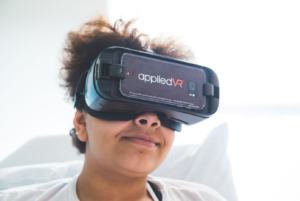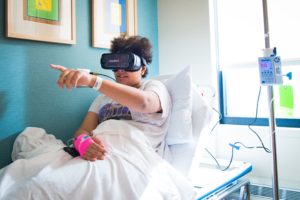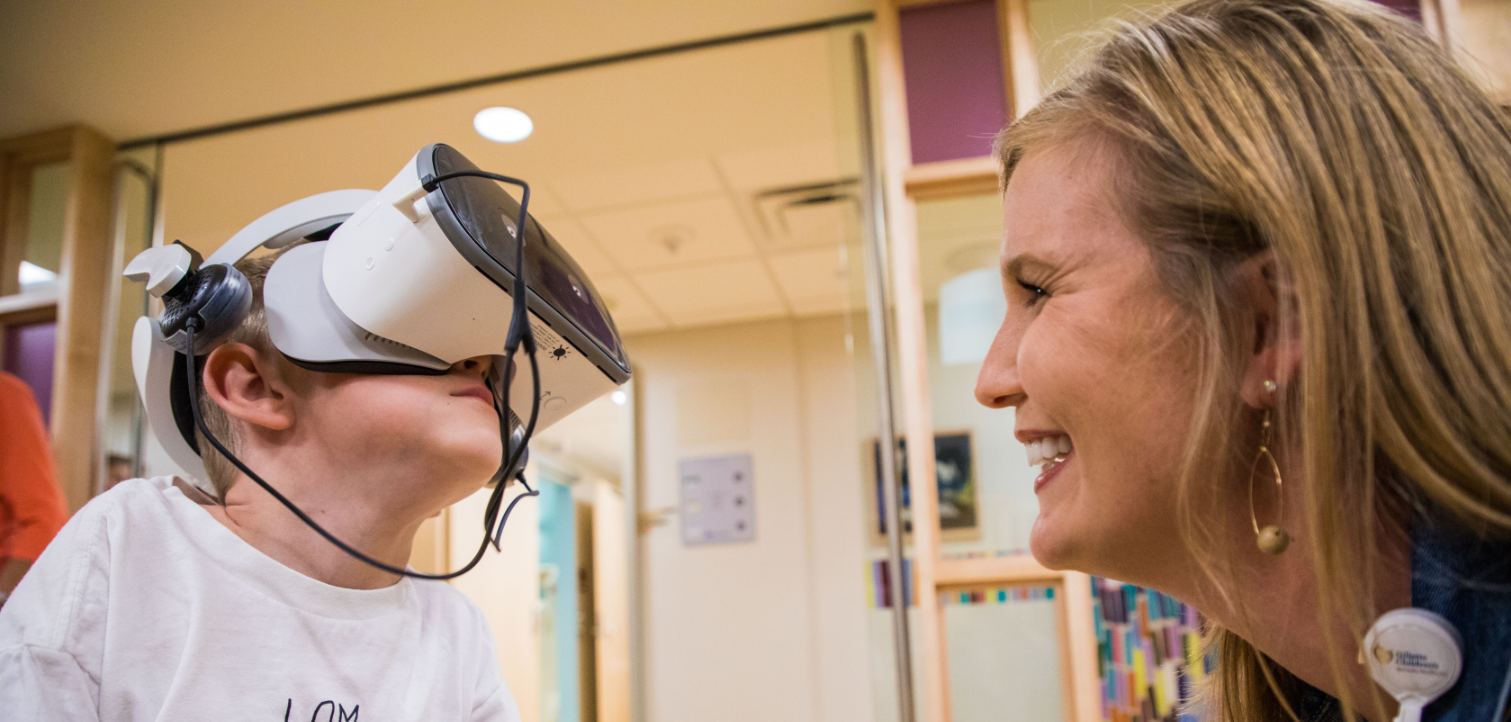When we and much of the virtual reality (VR) industry talks about the future of VR, topics typically circle around how the immersive technology can reinvent what it means to experience the digital world. We talk about how to make our good lives even better, less so how VR can help those dealt a more difficult hand in life.
That’s why we want to showcase how virtual reality is changing lives at Gillette Children’s Specialty Healthcare in St. Paul, Minnesota.
The Gillette Story
It was early 2017 when Chantel Barney, Clinical Scientist of Pain and Comfort Research at Gillette, read an article in Time Magazine about how virtual reality headsets (HMDs) can be used in hospitals to reduce pain. Intrigued by how this same technology could be used with Gillette patients, she reached out to other hospitals using VR for pain management. Hearing the success stories, Chantel took action. A few months later, Gillette’s Integrative Care Committee received two HMDs from appliedVR, a Los Angeles-based technology company that developed the first VR platform designed for healthcare.

According to appliedVR’s website, their VR technology “offers patients a highly enjoyable escape from scary and painful experiences in healthcare.” Check out this video explaining how the platform works.
Child life specialists at Gillette were given these VR HMDs with the hopes of making patient care as painless and anxiety-free as possible. Younger patients can start crying and feeling anxious two days ahead of the routine doctor visits that previously left them in pain and fearful for the next one. Parents sometimes don’t even want to give their kids treatment due to all the anxiety and potential pain involved. This is where VR has had its biggest impact already. VR helps by not only improving individual visits but having a compounding effect leading patients to be less fearful of future procedures.
It’s clear doctors and nurses love when their patients get to use VR, so Gillette is now working on multiple research studies to quantify the effectiveness of virtual reality as a pain management tool. Though still early, initial results are tremendously positive and could trigger much wider adoption of VR in healthcare.
After the initial success of Gillette’s work with appliedVR, the program expanded to over 30 HMDs, including the higher end Mirage Solo headsets donated by Disney’s Starlight Children’s Foundation.

Longer term plans for Gillette’s VR program include making VR an even more integral part of the patient experience, to the point where there is a decreased need for pharmacological interventions with known adverse side effects (e.g., opioids, sedatives, anxiolytics). Gillette is also experimenting with using VR to have utility beyond pain management. Some of those use cases include training staff and doctors, helping patients learn to walk again, and creating VR experiences taking place at Gillette’s own facilities to give patients a pre-procedure walkthrough designed to calm nerves on the day of a visit.
VR is currently being studied heavily at Stanford University in its ability to evoke empathy in people. This could be used in healthcare to create simulations that show parents and siblings of newly diagnosed patients how to understand what their child or brother/sister is going through.
Gillette’s Research on VR
Gillette was kind enough to share some of their training materials and research facts to help us better understand the tremendous potential of virtual reality in medical facilities like theirs. To learn more about Gillette’s research or for questions on how your medical facility can implement virtual reality technology, please contact Chantel Barney at CBarney@gillettechildrens.com.
Benefits of VR in Medical Facilities
- Allows patients to “step outside the hospital”
- VR may lead to improved procedural pain management, decreased the need for pharmacological interventions with known adverse side effects (e.g., opioids, sedatives, anxiolytics).
- Reduced general anesthesia needs
- Reduced sedation
- Reduced anxiety medications
- Analgesia coupled with VR is more effective than analgesia alone.
- Dramatically reduces pain assessment scores by as much as 40% and anxiety by as much as 60%
- VR can significantly reduce anxiety for both the patient and the parents/family
- Preventing pain and anxiety during a medical procedure has several important benefits:
- Reducing future phobias related to medical interventions (e.g., needle phobia)
- Medical trauma, PTSD
- Improved patient cooperation with medical staff
- Improved patient experience
- All leading to better child health outcomes
When VR Use Is Encouraged
- Painful procedures
- Anxiety-provoking procedures
- Waiting for care
- Normalizing the hospital
- During rehabilitation therapies
- During therapies while seated
- As a reward for hard work during session
Tips for Medical VR Use:
- Not a replacement for child life, music therapy, or extra staff.
- Not a replacement for standard medications used for procedural pain.
- Make a plan with the patient ahead of time:
- Do they want to know when the medical event is about to happen?
- Let them know they can take the VR off anytime.
- Let the patient know to stop if they feel sick or dizzy.
- Do they want someone to tell them when each step in the procedure is happening?
- What kind of experience do they want to have? (relaxation vs. a game)
- Familiarize yourself with the content so you can match the patient’s needs to the different types of experiences.
- Coach the patient through the VR experience to keep them engaged (e.g., “what do you see now”)
Ways VR Has Been Used at Gillette to Date:
- IV starts
- Pre-lumbar puncture
- Post-surgical pain
- Pre-MRI anxiety
- Infusion center
- PT/OT/speech
- Sibling and parent use
- Pre-op anxiety
- Mask inductions
- Casting and cast removal
- Pin removal
- Botox injections for muscle spasticity
Patient Restrictions:
- Not for patients with seizures
- Not for patients with claustrophobia
- Ages 4 years+ (due to head size)
- Ensure skin integrity on the head or use a surgical cap to protect skin
- Patients should be sitting or lying down during VR
VR Over iPads and TVs
Now you might be asking yourself, is VR really that much more effective than more traditional forms of distraction like TVs and iPads? We asked Chantel that exact question, and her answer was a resounding yes. Distraction techniques have always been effective, but the beauty of VR is that it makes you feel like you are in another world. Patients can move from just being distracted to having powerful, out of body experiences like visiting Paris or a beach all from their hospital bed. These simulations are thought to be highly effective forms of distraction while simultaneously evoking positive emotions resulting in the release of positive chemicals in the brain – which all together can produce an analgesic effect.

Another benefit of using VR is the fact that the device is placed over the patient’s eyes. This has two benefits; the patient forgets they are in a room full of doctors and nurses and the patient might not always be able to hold a device in their hand.
Overall, VR is proving to be the most effective technology to date in removing a patient from the pain and anxiety associated with medical procedures.
Conclusion
We talk so much about how regular people can use VR to do anything, go anywhere or be anyone right from their living room. What we learned after talking with Chantel Barney from Gillette Children’s Specialty Healthcare was that these same wonders that make VR such a transcendent experience in everyday life can have the same if not a more of an impact in healthcare.
These are the stories that keep us optimistic about the ways technology can better humanity.
Disclaimer: We actively write about the themes in which we invest or may invest: virtual reality, augmented reality, artificial intelligence, and robotics. From time to time, we may write about companies that are in our portfolio. As managers of the portfolio, we may earn carried interest, management fees or other compensation from such portfolio. Content on this site including opinions on specific themes in technology, market estimates, and estimates and commentary regarding publicly traded or private companies is not intended for use in making any investment decisions and provided solely for informational purposes. We hold no obligation to update any of our projections and the content on this site should not be relied upon. We express no warranties about any estimates or opinions we make.
